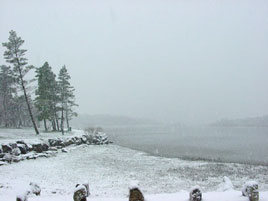Argon doesn’t get along too well with other elements – in the sense that it just doesn’t hook up to form compounds with any other element apart from the slight possibility that it can be reacted with fluorine - but chemists are sceptical about reports of any argon-fluorine compounds. While it doesn’t get along with other elements it is very good at dating. Not speed-dating or blind-dating, but rock-dating or groundwater dating or dating of ice cores – just some of the ways that argon is useful for dating old materials. Because it is so inert and unreactive argon is also useful in preventing fires and protecting sensitive processes where oxygen especially may interfere – the making of silicon chips is one example. Like that other inert gas, neon, it is also useful in light bulbs.
Argon is all rounds us – it accounts for almost 1% of the atmosphere so you probably breathe in and out a third of a kilogram of argon each day.
Dating old things and putting events into a chronological sequence fascinates me and I suspect it is also a fascination for many other scientists. Things happen in a sequence – over time – and of course time is what stops everything happening at once as someone of great insight once remarked! Accurately gauging the sequence of events over aeons of time is a detective story in itself. Today scientists have a great variety of methods for putting a date on a natural events and for producing chronologies over very long periods of time. Mud cores from lakes for example. The mud at the bottom of Lough Mask and indeed at the bottom of every other reasonably deep Irish lake carries a sequential record of everything that has happened in the surrounding catchment of the lake. And that goes tight back to its formation 12,000 years ago when the ice retreated at the end of the Ice Age. Much older are the lakes in Africa’s famous Rift Valley which were formed millions of years ago – and they will have an even longer record just as seabed sediments do.
The chronology is gauged by changes in the mud chemistry or by recording the species of insects preserved or the silica shells of tiny diatoms preserved so well that they can be identified under a high power microscope. Similarly, tree rings carry very precise records of growing conditions year after year. Now it’s possible to time travel back many thousands of years by using overlapping tree ring patterns found on hundreds of different pieces of timber each of which overlaps slightly with the ring pattern from another tree – either younger or older. A tree that is a century old will have precisely 100 rings on its trunk – one for each growing season. Variation in growing conditions each year – temperature, water, light – determine the year to year variation in the width of each year’s ring of timber laid down during the growing season. Over the life of a typical tree this sequence will be unique for the decades involved and can be readily matched up with the same decades on a tree which is say 50 years older or younger. In this way by sliding the tree ring sequences over each other and matching them up, a continuous sequence has been formed which goes back thousands of years. There is a limit to how far back we can go with this method, however, possibly 5000 to 10,000 years. Within this time frame precisely dated tree rings can be used to calibrate radioactive carbon dating.
In order to put a date on material that is older than this, however, argon is probably your only man. Potassium-Argon dating in particular can go back 4 billion years plus or minus a few of course. Based on a principle that fundamental physical and chemical characteristics of matter don’t change over time it is possible to extrapolate from what we observe today right back into the dim and distant past. Potassium 40, for example, is a slightly radioactive form of potassium which every so often changes to argon 40 by means of what is called radioactive decay – something like tooth decay only a bit more glamorous and of course on a much smaller sub atomic scale. Every so often an electron defects from its orbit around the nucleus and smashes into a proton, neutralising it and turning it into a neutron with the result that – hey presto! – the potassium atom has now become an argon atom instead. The changing of one element into another like this is an alchemist’s dream but it nonetheless it does occur naturally all the time in nature. Potassium 40 has a half-life of 1.26 billion years meaning that in 1.26 billion years half of the initial amount of potassium 40 present will have been converted to argon 40. Thus, using the amount of argon 40 left in a piece of volcanic rock we can tell when it was formed even if this was 3 or 4 billion years ago. Obviously it’s not quite as simple as this but the basic idea is very sound and very useful even though it’s pretty impossible to get the mind around the concept of a billion years – one thousand million years. Hard enough to remember 1987 never mind one billion years ago.
 |
| Global warming may cause unexpected results! |
Ice core dating is based on a similar principle – tracking climate change using bubbles of air trapped in the ice. As the ice was laid down in for examples the glaciers of Greenland or Antarctica, for example, tiny bubbles are trapped as the water froze. By analysing the argon isotopes contained within this air a lot can be learned about the age of the ice and other gases can reveal information about the temperature at the time – hot or cold? Ice Age or interglacial?
These ice cores are some of the main sources of fears about climate change. Recently our imaginations have been caught by the idea that the North Atlantic Drift could suddenly shut down due to global warming. Then, somewhat ironically perhaps, this would precipitate an Ice Age as the warming influence of the Gulf Stream ceases and ice and snow take hold in Northern Europe like they haven’t done for 12,000 years or so. Ice cores can help to elucidate the possibilities of such an event or sequence of events occurring. There seems to be some evidence that the escalator that is the North Atlantic Drift has ceased operating over a relatively short timescale of decades in the past. Certainly there are huge worries currently about the possibility of melting polar ice at the North Pole. There is no land beneath Santa’s workshops up there at the North Pole on the ice cap. So if it melts – Santa drowns!
The ocean currents such as conveyor belt that drives the North Atlantic Drift are driven in large part by dense salty water being cooled as it approaches the polar ice. This heavy salt water sinks and drives the southward procession of the conveyor belt until it re-emerges in the tropics and then runs back up along the surface as the so called ‘Gulf Stream’ which is like a fast-flowing river travelling diagonally across the North Atlantic Ocean. The top layers of the Greenland ice cores, which are kilometres in length, show that it has been working away merrily for the past thousands of years: at least since the last Ice Age. But older, deeper sections of the cores which provide a record that stretches back over 100,000 years show that the circulation pattern can break down and relatively rapidly.
 |
| The Mall on a Summers Day? |
Measurements in the sea off the northern ice pack has shown that large areas of very cold water of low salinity have turned up recently. This water is not as dense as the salty water that is cooled by the ice as it hits the high latitudes way up north – so it doesn’t sink as well as the heavier salty water. It is predicted that if this field of cold fresh water were to double in size it would prevent the formation of deep water Labrador current. The source of this cold fresh water appears to be a combination of ice melt – there is very little salt in ice – and increased precipitation.
Most models of global warming predict wetter weather in northern latitudes as the moisture picked up from the warmer southern oceans is transported north and then returned to the sea and land as rain or snow. Precipitation has increased in some northern countries over the past 30 years. Already this kind of basic climate change has required scientists to ignore long-term averages of 100 year or 50 year records because they are no longer useful in terms of uses such as predicting flood events. Anything beyond a 30-year average is not of great value due to the quantum change that has occurred in the recent past. In any case it now appears that large volumes of less dense, less salty water stretching over very large areas near the polar ice have the potential to shut down the normal pattern of circulation. Obviously a lot of pretty urgent research and measurements are currently under way to get a better handle on what the hell is going on up North. The models are very complex but depending on the balance between a number of factors such as ice melt, salinity, precipitation, extent of ice cover which are all inter-related there are a number of scenarios which predict that the North Atlantic Drift could suddenly switch off.
The West Coast of Norway is at least 10°C warmer than the equivalent latitude in Alaska at the moment. If our mean winter temperature dropped by 10°C that would make Castlebar and the West of Ireland a pretty cold place to be living. We’d survive alright as long as the climate didn’t switch into a full scale Ice Age burying us beneath the snow. Certainly our houses and way of life here in Ireland would be totally inadequate to cope with prolonged periods of cold, icy weather such as that experienced in Iceland or Greenland. Perhaps the warming trend would counteract the cooling experienced when the Gulf Stream stops but our climate is too complex to make that kind of prediction. The one sure thing is that we won’t like the final result of runaway climate change so it is better to start to think seriously about reducing our carbon dioxide outputs.
Previous Element: Catastrophic Chlorine